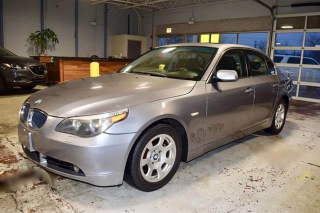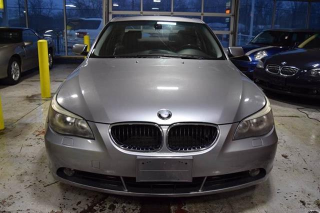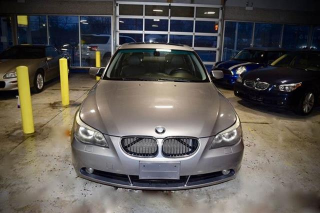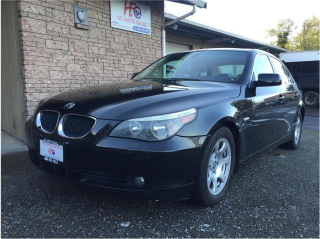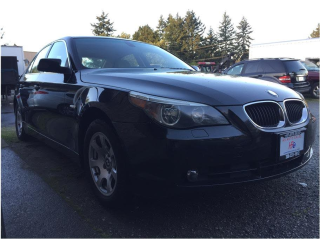The Good
The 2004 BMW 5 Series offers a compelling blend of performance and luxury. Its responsive engines and sporty handling provide an engaging driving experience. The comfortable and well-appointed interior, combined with distinctive styling, appeals to emotional buyers. For practical buyers, it offers a spacious cabin, decent fuel economy for its class, and a reputation for solid engineering (though maintenance can be costly).
The Bad
The 2004 BMW 5 Series (E60) is known for potential electrical issues, including problems with the iDrive system, sensors, and control modules. Oil leaks, particularly around the valve cover gasket, are also common. Suspension components, like control arms, can wear out, leading to increased maintenance costs. It's crucial to check the car's service history carefully.
2004 BMW 5 Series: Quick Overview
Here's a summary of key specifications for the 2004 BMW 5 Series:
- Engine Options:
- 525i: 2.5L Inline-6
- 530i: 3.0L Inline-6
- 545i: 4.4L V8
- Horsepower:
- 525i: 184 hp
- 530i: 225 hp
- 545i: 325 hp
- Fuel Economy (MPG): (Estimates vary based on driving conditions)
- 525i: 20 city / 29 highway (approximate)
- 530i: 19 city / 28 highway (approximate)
- 545i: 16 city / 24 highway (approximate)
- 0-60 Times: (Approximate)
- 525i: 8.1 seconds
- 530i: 6.7 seconds
- 545i: 5.8 seconds
- Towing Capacity: The 2004 BMW 5 Series is not generally recommended or equipped for towing.
- Trim-Level Features:
- 525i: Standard features include automatic climate control, power front seats, premium sound system, and leatherette upholstery.
- 530i: Adds premium leather upholstery, wood trim, and upgraded audio system and often includes optional sport package.
- 545i: Includes the V8 engine, premium leather, upgraded interior trim, and various performance enhancements. It typically has more standard luxury features.
2004 BMW 5 Series Specifications
Vehicle Information
| Year | 2004 |
| Make | BMW |
| Model | 5-Series |
| Trim | - |
| Style | Sedan Rear-Wheel Drive |
| Type | Sedan |
| Category | Compact Car |
Manufacturing Details
| Made In | Germany |
| Manufacturing City | DINGOLFING |
Dimensions
| Doors | 4-Door |
| Curb Weight | 3450 pounds |
| Gross Vehicle Weight Rating | - |
| Overall Height | 58.00 inches |
| Overall Length | 190.60 inches |
| Overall Width | 72.70 inches |
| Wheelbase Length | 113.70 inches |
| Standard Seating | 5 |
Engine & Performance
| Engine | 2.5-L I6 |
| Engine Size | 2.5L |
| Engine Cylinders | 6 |
| Transmission | 6-Speed Automatic |
| Transmission Type | Automatic |
| Transmission Speeds | 6-Speed |
| Drivetrain | Rear-Wheel Drive |
Additional Features
| Anti-Brake System | 4-Wheel ABS |
| Steering Type | Rack & Pinion |
Pricing
| Manufacturer Suggested Retail Price (MSRP) | $39,800 |
| Invoice Price | $36,380 |
| Delivery Charges | $695 |
Vehicle History Report
Specifications
History
Events
History Check
Check
Check
Check
Check
Listings
Recalls
Check
Analysis
What Problems Does the 2004 BMW 5 Series Have?
Cooling system failures, including water pump and thermostat malfunctions, are also a concern. Suspension components, like control arms and bushings, tend to wear out, leading to increased maintenance needs. Some owners have reported issues with the automatic transmission, though this is less frequent than other problems mentioned.
Recalls for the 2004 5 Series have included issues related to airbags and fuel pump failures. It's important to check the vehicle's VIN with the NHTSA (National Highway Traffic Safety Administration) to verify whether all applicable recalls have been addressed.
Long-term reliability can be a concern due to the complexity of the vehicle's systems. Regular and diligent maintenance is critical to prevent major breakdowns. The cost of repairs can be relatively high due to the specialized parts and labor required for BMWs. Addressing issues promptly can help prevent them from escalating into more significant problems.
How long will the 2004 BMW 5 Series last?
What Technology & Safety Features are Included?
Safety features included front and side airbags, as well as head protection airbags for both front and rear occupants. Run-flat tires were also available as an option. Optional features included parking sensors, adaptive cruise control, and active steering.
The IIHS (Insurance Institute for Highway Safety) gave the 2004 BMW 5 Series generally good ratings in its crash tests. The NHTSA (National Highway Traffic Safety Administration) also provided crash-test ratings, which should be consulted for specific performance details. Remember that safety technology has advanced significantly since 2004, so while the 5 Series was considered safe at the time, it lacks many of the advanced driver-assistance systems (ADAS) found in newer vehicles, such as automatic emergency braking and lane departure warning.
What Colors Options are Available?
Exterior Colors
Interior Colors
2004 BMW 5 Series Prices and Market Value
The 2004 5 Series has depreciated significantly due to its age and the higher maintenance costs associated with older luxury vehicles. Factors affecting resale value include mileage, condition (both mechanical and cosmetic), service history, and the presence of desirable options. Cars with a clean title and documented maintenance history will generally fetch higher prices.
2004 BMW 5 Series Cost of Ownership
2004 BMW 5 Series Fuel Efficiency
2004 BMW 5 Series Safety Rating
NHTSA
IIHS
2004 BMW 5 Series Warranty
Basic
Powertrain
Rust
2004 BMW 5 Series Insurance
reasonable repair costs.
How Does the 2004 BMW 5 Series Compare to Other Sedan?
In terms of features, the BMW offered a comparable level of luxury and technology to its rivals, although the iDrive system was initially criticized for its complexity. Reliability is where the BMW falls short compared to the Lexus GS, which consistently ranked higher in reliability surveys. The Mercedes-Benz E-Class also had its share of reliability issues during this period, but was generally considered more reliable than the BMW.
In terms of price, the BMW was generally competitive with its German rivals. However, given the potential for higher maintenance costs and reliability concerns, potential buyers might consider the Lexus GS for its superior reliability. The Acura TL of the same era offers similar features and reliability at a much lower price point, although it lacks the prestige of the German brands. A well-maintained Audi A6 with quattro can offer a similar driving experience with a potentially lower purchase price, but maintenance costs can still be significant.
Ranks #740 Sedan
| 1 | 2023 Toyota Camry | (5.0★) |
| 2 | 2023 Honda Accord | (0.0★) |
| 3 | 2023 Lexus ES | (0.0★) |
| 4 | 2024 Subaru Legacy | (5.0★) |
| 5 | 2022 Mazda MX-30 | (5.0★) |
| 6 | 2024 BMW M3 | (0.0★) |
| 7 | 2023 Ford Mustang | (5.0★) |
| 8 | 2023 Mercedes-Benz AMG GT | (0.0★) |
| 9 | 2023 Audi A3 | (0.0★) |
| 10 | 2023 Chevrolet Camaro | (5.0★) |
| 11 | 2023 Hyundai Elantra Hybrid | (0.0★) |
| 12 | 2023 Nissan Altima | (4.0★) |
| 740 | 2004 BMW 5 Series | (0.0★) |
